2017 PEUGEOT 5008 gearbox
[x] Cancel search: gearboxPage 263 of 404
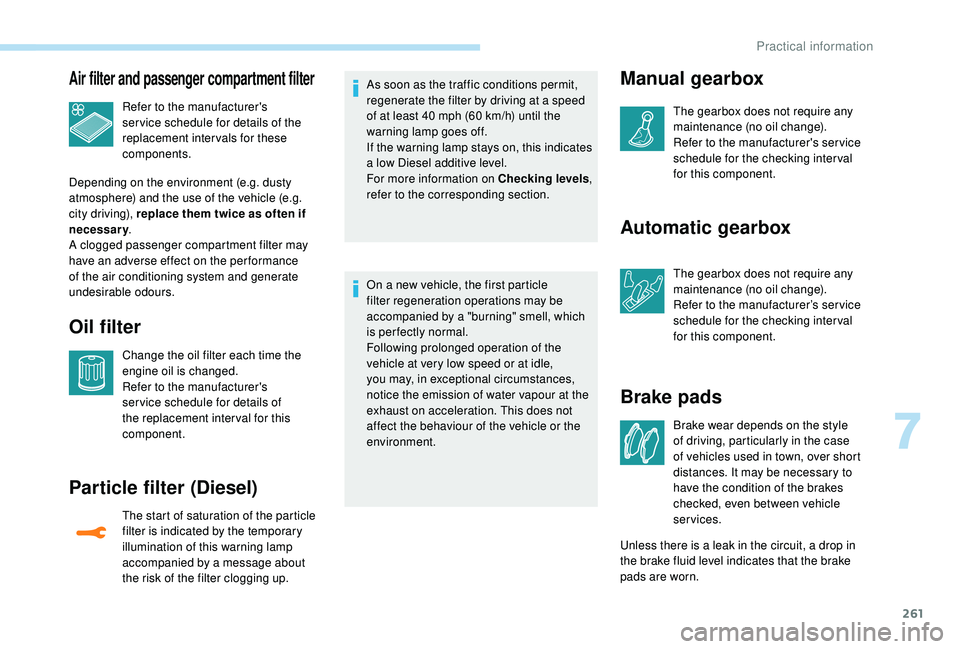
261
Air filter and passenger compartment filter
Refer to the manufacturer's
ser vice schedule for details of the
replacement intervals for these
components.
Depending on the environment (e.g. dusty
atmosphere) and the use of the vehicle (e.g.
city driving), replace them twice as often if
necessary .
A clogged passenger compartment filter may
have an adverse effect on the per formance
of the air conditioning system and generate
undesirable odours.
Oil filter
Change the oil filter each time the
engine oil is changed.
Refer to the manufacturer's
ser vice schedule for details of
the replacement inter val for this
component.
Particle filter (Diesel)
The start of saturation of the particle
filter is indicated by the temporary
illumination of this warning lamp
accompanied by a message about
the risk of the filter clogging up. As soon as the traffic conditions permit,
regenerate the filter by driving at a speed
of at least 40
mph (60 km/h) until the
warning lamp goes off.
If the warning lamp stays on, this indicates
a low Diesel additive level.
For more information on Checking levels ,
refer to the corresponding section.
On a new vehicle, the first particle
filter regeneration operations may be
accompanied by a "burning" smell, which
is per fectly normal.
Following prolonged operation of the
vehicle at very low speed or at idle,
you may, in exceptional circumstances,
notice the emission of water vapour at the
exhaust on acceleration. This does not
affect the behaviour of the vehicle or the
environment.
Manual gearbox
The gearbox does not require any
maintenance (no oil change).
Refer to the manufacturer's service
schedule for the checking inter val
for this component.
Automatic gearbox
The gearbox does not require any
maintenance (no oil change).
Refer to the manufacturer’s service
schedule for the checking inter val
for this component.
Brake pads
Brake wear depends on the style
of driving, particularly in the case
of vehicles used in town, over short
distances. It may be necessary to
have the condition of the brakes
checked, even between vehicle
services.
Unless there is a leak in the circuit, a drop in
the brake fluid level indicates that the brake
pads are worn.
7
Practical information
Page 275 of 404
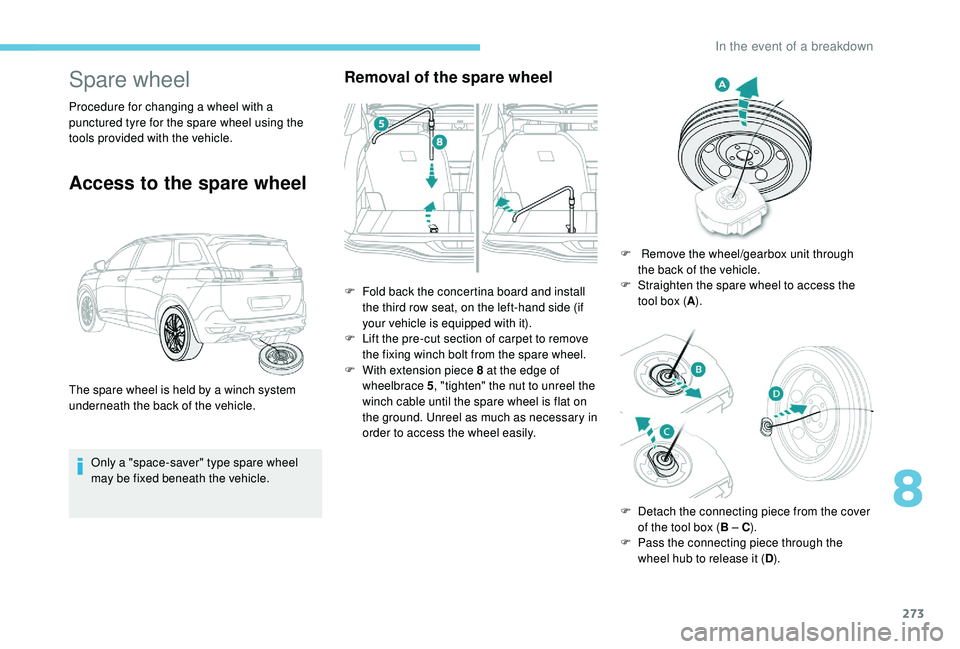
273
Spare wheel
Procedure for changing a wheel with a
punctured tyre for the spare wheel using the
tools provided with the vehicle.
Access to the spare wheel
Only a "space-saver" type spare wheel
may be fixed beneath the vehicle.
Removal of the spare wheel
The spare wheel is held by a winch system
underneath the back of the vehicle.F
F
old back the concertina board and install
the third row seat, on the left-hand side (if
your vehicle is equipped with it).
F
L
ift the pre-cut section of carpet to remove
the fixing winch bolt from the spare wheel.
F
W
ith extension piece 8 at the edge of
wheelbrace 5 , "tighten" the nut to unreel the
winch cable until the spare wheel is flat on
the ground. Unreel as much as necessary in
order to access the wheel easily. F
R
emove the wheel/gearbox unit through
the back of the vehicle.
F
S
traighten the spare wheel to access the
tool box ( A).
F
D
etach the connecting piece from the cover
of the tool box ( B – C).
F
P
ass the connecting piece through the
wheel hub to release it ( D).
8
In the event of a breakdown
Page 277 of 404
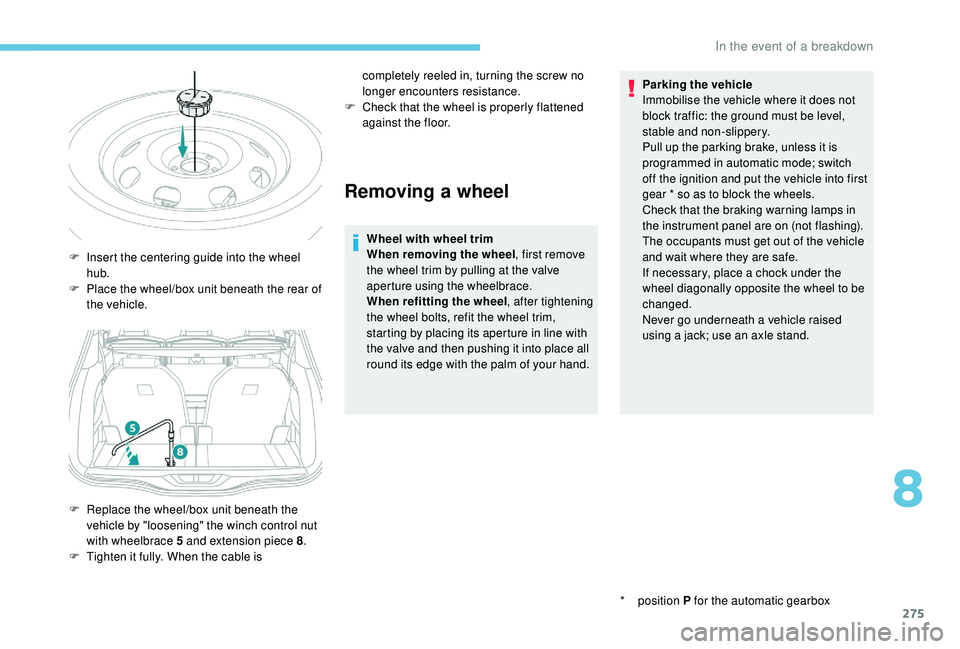
275
Removing a wheel
Wheel with wheel trim
When removing the wheel, first remove
the wheel trim by pulling at the valve
aperture using the wheelbrace.
When refitting the wheel , after tightening
the wheel bolts, refit the wheel trim,
starting by placing its aperture in line with
the valve and then pushing it into place all
round its edge with the palm of your hand.
*
position P for the automatic gearbox
F
I
nsert the centering guide into the wheel
hub.
F
P
lace the wheel/box unit beneath the rear of
the vehicle.
F
R
eplace the wheel/box unit beneath the
vehicle by "loosening" the winch control nut
with wheelbrace 5
and extension piece 8 .
F
T
ighten it fully. When the cable is completely reeled in, turning the screw no
longer encounters resistance.
F
C
heck that the wheel is properly flattened
against the floor. Parking the vehicle
Immobilise the vehicle where it does not
block traffic: the ground must be level,
stable and non-slippery.
Pull up the parking brake, unless it is
programmed in automatic mode; switch
off the ignition and put the vehicle into first
gear * so as to block the wheels.
Check that the braking warning lamps in
the instrument panel are on (not flashing).
The occupants must get out of the vehicle
and wait where they are safe.
If necessary, place a chock under the
wheel diagonally opposite the wheel to be
changed.
Never go underneath a vehicle raised
using a jack; use an axle stand.
8
In the event of a breakdown
Page 289 of 404
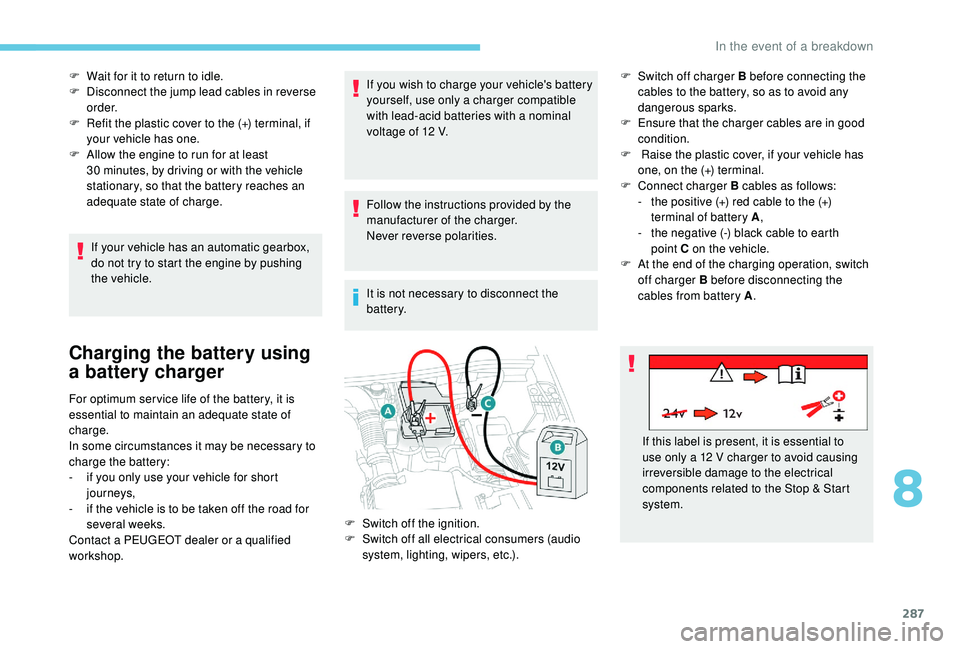
287
F Wait for it to return to idle.
F D isconnect the jump lead cables in reverse
o r d e r.
F
R
efit the plastic cover to the (+) terminal, if
your vehicle has one.
F
A
llow the engine to run for at least
30
minutes, by driving or with the vehicle
stationary, so that the battery reaches an
adequate state of charge.
If your vehicle has an automatic gearbox,
do not try to start the engine by pushing
the vehicle.
Charging the battery using
a battery charger
For optimum ser vice life of the battery, it is
essential to maintain an adequate state of
charge.
In some circumstances it may be necessary to
charge the battery:
-
i
f you only use your vehicle for short
journeys,
-
i
f the vehicle is to be taken off the road for
several weeks.
Contact a PEUGEOT dealer or a qualified
workshop. If you wish to charge your vehicle's battery
yourself, use only a charger compatible
with lead-acid batteries with a nominal
voltage of 12 V.
Follow the instructions provided by the
manufacturer of the charger.
Never reverse polarities.
It is not necessary to disconnect the
battery.
F
S
witch off charger B before connecting the
cables to the battery, so as to avoid any
dangerous sparks.
F
E
nsure that the charger cables are in good
condition.
F
R
aise the plastic cover, if your vehicle has
one, on the (+) terminal.
F
C
onnect charger B cables as follows:
-
t
he positive (+) red cable to the (+)
terminal of battery A ,
-
t
he negative (-) black cable to earth
point C on the vehicle.
F
A
t the end of the charging operation, switch
off charger B before disconnecting the
cables from battery A .
F
S
witch off the ignition.
F
S
witch off all electrical consumers (audio
system, lighting, wipers, etc.). If this label is present, it is essential to
use only a 12
V charger to avoid causing
irreversible damage to the electrical
components related to the Stop & Start
system.
8
In the event of a breakdown
Page 292 of 404

290
F Move the gear lever into neutral (N mode with an automatic gearbox).
Failure to follow this instruction may cause
damage to some components (braking,
transmission, etc.) and the absence of
braking assistance when the engine is
restarted. F
S
witch on the hazard warning lamps on
both vehicles.
F
S
et off gently and drive slowly for a short
distance.
Towing another vehicle
To access the rear screw thread:
F
P
ress the top left corner of the cover plate
then press the bumper to the right of the
cover plate, until it unclips.
F
S
crew the towing eye in fully, until it reaches
a stop.
F
I
nstall the towbar.
F
S
witch on the hazard warning lamps on
both vehicles.
F
S
et off gently and drive slowly for a short
distance. General recommendations
Obser ve the legislation in force in your
c o u nt r y.
Ensure that the weight of the towing
vehicle is greater than that of the towed
vehicle.
The driver must remain at the wheel of
the towed vehicle and must have a valid
driving licence.
When towing a vehicle with all four
wheels on the ground, always use an
approved towing arm; rope and straps are
prohibited.
The towing vehicle must move off gently.
When the vehicle is towed with its engine
off, there is no longer braking and steering
assistance.
In the following cases, you must always
call on a professional recovery ser vice:
-
v
ehicle broken down on a motor way or
fast road,
-
f
our-wheel drive vehicle,
-
w
hen it is not possible to put the
gearbox into neutral, unlock the
steering, or release the parking brake,
-
t
owing with only two wheels on the
ground,
-
w
here there is no approved towbar,
etc. available.
F
S
crew the towing eye in fully, until it reaches
a stop.
F
I
nstall the towbar.
Model with "Full LED" headlamps
F
P
ress the top right corner, then, while still
holding, slide your finger to the left until the
cover plate unclips.
F
U
nlock the steering and release the
parking brake.
In the event of a breakdown
Page 294 of 404
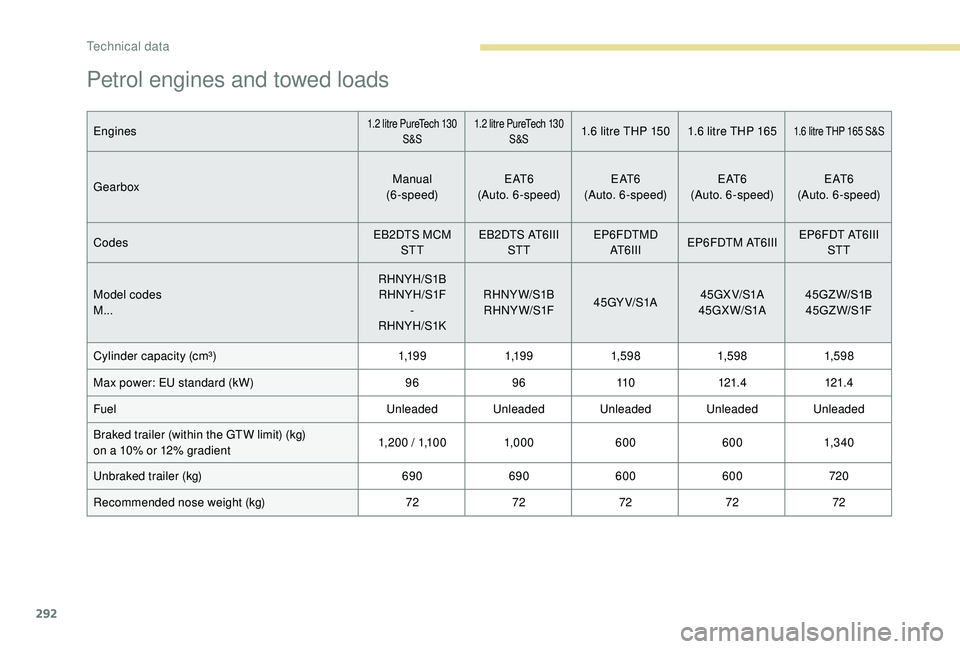
292
Petrol engines and towed loads
Engines1.2 litre PureTech 130
S&S 1 .2 litre PureTech 130
S&S1.6 litre THP 150 1 .6 litre THP 1651.6 litre THP 165 S&S
Gearbox Manual
(6-speed) E AT 6
(Auto. 6-speed) E AT 6
(Auto. 6-speed) E AT 6
(Auto. 6-speed) E AT 6
(Auto. 6-speed)
Codes EB2DTS MCM
STT EB2DTS AT6III
STT EP6FDTMD
AT6III EP6FDTM AT6III EP6FDT AT6III
STT
Model codes
M... RHNYH/S1B
RHNYH/S1F -
RHNYH/S1K RHNYW/S1B
RHNYW/S1F 45GY V/S1A45GX V/S1A
45GX W/S1A 45GZ W/S1B
45G Z W/S1F
Cylinder capacity (cm³) 1,1 9 91,1 9 91,59 8 1,59 81,59 8
Max power: EU standard (kW) 969611 0121.4 121.4
Fuel Unleaded Unleaded Unleaded Unleaded Unleaded
Braked trailer (within the GTW limit) (kg)
on a 10% or 12% gradient 1, 20 0
/ 1,10 01,000 6006001,3 4 0
Unbraked trailer (kg) 690690600 600 720
Recommended nose weight (kg) 7272727272
Technical data
Page 295 of 404
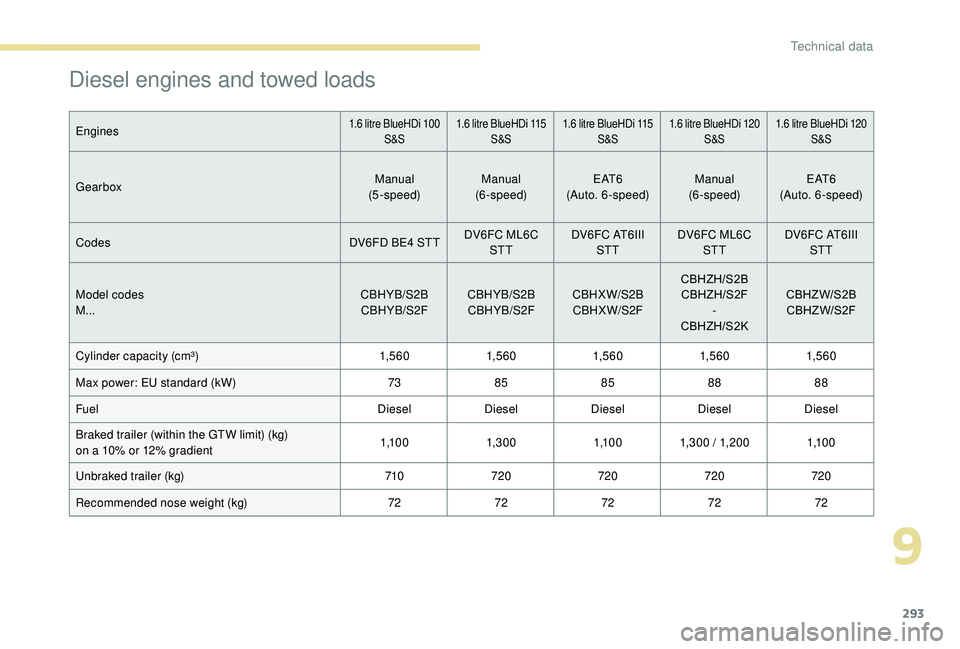
293
Diesel engines and towed loads
Engines1.6 litre BlueHDi 100
S&S 1 .6 litre BlueHDi 115
S&S 1 .6 litre BlueHDi 115
S&S 1 .6 litre BlueHDi 120
S&S 1 .6 litre BlueHDi 120
S&S
Gearbox Manual
(5-speed) Manual
(6-speed) E AT 6
(Auto. 6-speed) Manual
(6-speed) E AT 6
(Auto. 6-speed)
Codes DV6FD BE4
STTDV6FC ML6C
STT DV6FC AT6III
STT DV6FC ML6C
STT DV6FC AT6III
STT
Model codes
M... CBHYB/S2B
CBHYB/S2F CBHYB/S2B
CBHYB/S2F CBHXW/S2B
CBHXW/S2F CBHZH/S2B
CBHZH/S2F -
CBHZH/S2K CBHZW/S2B
CBHZW/S2F
Cylinder capacity (cm³) 1,5 6 01,5 6 01,5 6 01,5 6 01,5 6 0
Max power: EU standard (kW) 7385 8588 88
Fuel DieselDieselDieselDieselDiesel
Braked trailer (within the GTW limit) (kg)
on a 10% or 12% gradient 1,1 0 0
1,3 0 0 1,1 0 01,3 0 0
/ 1, 20 01,1 0 0
Unbraked trailer (kg) 710720 720720720
Recommended nose weight (kg) 7272727272
9
Technical data
Page 296 of 404
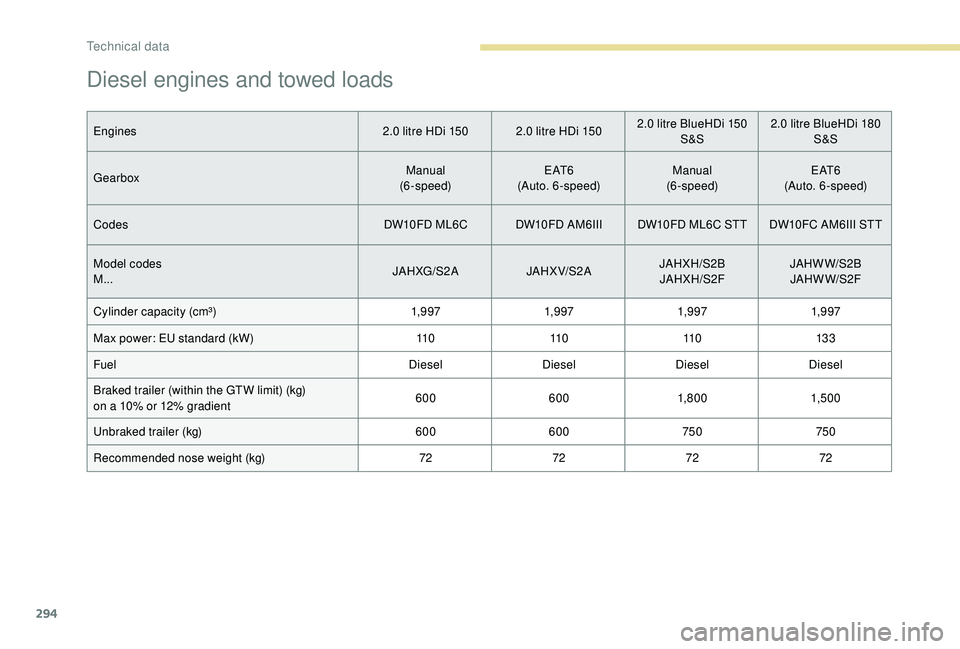
294
Diesel engines and towed loads
Engines2.0 litre HDi 150 2.0 litre HDi 1502.0 litre BlueHDi 150
S &S2.0
litre BlueHDi 180
S &S
Gearbox Manual
(6-speed) E AT 6
(Auto. 6-speed) Manual
(6-speed) E AT 6
(Auto. 6-speed)
Codes DW10FD ML6C DW10FD AM6IIIDW10FD ML6C STT DW10FC AM6III STT
Model codes
M... JAHXG/S2 A
JAHX V/S2 AJAHXH/S2B
JAHXH/S2F JAHWW/S2B
JAHWW/S2F
Cylinder capacity (cm³) 1,9 971,9 971,9 971,9 97
Max power: EU standard (kW) 11 011 011 013 3
Fuel DieselDieselDieselDiesel
Braked trailer (within the GTW limit) (kg)
on a 10% or 12% gradient 600
6001,8 0 0 1,5 0 0
Unbraked trailer (kg) 600600 750750
Recommended nose weight (kg) 72727272
Technical data